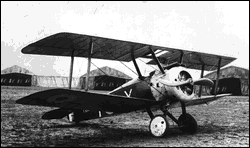Sopwith Camel F.1
 First
flown on May 17, 1917, the
Sopwith Camel F.1 was the Allies premier fighter in WWI. Designed to replace unsuccessful Sopwith "Pup", it quickly went into production and a total
of 5,490 were built. The "Camel" demonstrated good handling and its armament of
two 7.62 mm Maxim or two Vickers 0.030 machine guns was formidable. The name
"Camel" was derived from the hump-shaped cover over the machine guns. In order
to combat Zeppelins, 2F.1 Camels were flown from barges towed behind destroyers, from
platforms on the gun turrets of larger ships as well as from early aircraft carriers. A
2F.1 successfully flew after being dropped from an airship, an experiment testing an
airship's ability to carry its own defensive aircraft. An armored trench-fighting version
was flown, but did not go into production.
First
flown on May 17, 1917, the
Sopwith Camel F.1 was the Allies premier fighter in WWI. Designed to replace unsuccessful Sopwith "Pup", it quickly went into production and a total
of 5,490 were built. The "Camel" demonstrated good handling and its armament of
two 7.62 mm Maxim or two Vickers 0.030 machine guns was formidable. The name
"Camel" was derived from the hump-shaped cover over the machine guns. In order
to combat Zeppelins, 2F.1 Camels were flown from barges towed behind destroyers, from
platforms on the gun turrets of larger ships as well as from early aircraft carriers. A
2F.1 successfully flew after being dropped from an airship, an experiment testing an
airship's ability to carry its own defensive aircraft. An armored trench-fighting version
was flown, but did not go into production.
Although mainly used in western Europe, Camels also served in Italy.
Some Camels were assigned to home defense, with the cockpit positioned further back and
guns placed on the upper wings. The Camel 2F.1 was produced for the RNAS with more
powerful engines. It became one of the most famous planes of World War I, responsible for
shooting down 1,294 enemy aircraft.
The Camel was strong and agile but prone to springing surprises on the
inexperienced pilot. The Camel was a fighter pilot's dream come true. It was fast,
maneuverable and equipped with two machine guns synchronized to fire forward through the
propeller arc, but it was not suitable for the novice. It could out turn any German
aircraft of the time if handled without respect, would throw itself into a dangerous spin.
If the pilot was experienced and adept at flying he could usually master the quirks of the
Camel, if not, the pilot in training frequently died. It was a very powerful aircraft
powered by a 127 hp Clerget rotary engine. The power and torque generated by the engine
coupled with the masses of the motor, the pilot, guns, ammo and fuel in one small area
gave the Camel a very tight turning radius to the right. Taking off was hazardous as the
pilot had to apply considerable left rudder and aileron to avoid torquing the airplane
into the ground once it took off. The Camel was a match for the German triplane at turning
to the right, so an experienced Allied pilot could whip the Camel to the right and come
onto the tail of even a Fokker Dridecker. It was said that some pilots made a 270 degree
right turn rather than a left turn as it was quicker that way. The Camel and the SE5a
spelled the end of the Germans in the air, even in their new Fokker DVIIs. There were just
too many Camels and SE5as. Baron Manfred von
Richthofen was shot down in his Dr.III probably by A.R. Brown flying a Camel.
A Canadian pilot, Major W.G. Barker,
destroyed 41 enemy aircraft while flying Camels.

SPECIFICATIONS
Country: Great Britain
Manufacturer: Sopwith
Designation: Camel
Service date: June, 1917
Wingspan: 28 ft.
Length: 18' 9"
Height: 8' 6"
Empty weight: 928 lbs
Takeoff weight: 1,450 lbs
Armament
Two 7.62 mm Maxim machine guns or two belt-fed Vickers 0.303 machine
guns.
Four 20 lb bombs
PERFORMANCE
Engine: 95kW Clerget 9B rotary engine 127 hp
Max. speed: 113 mph
Climb rate: 14.4 ft/sec
Ceiling: 19,000 ft
Range: 217 miles
U. S. Fighter Home Page | 'Aces' Home Page | Feedback
 First
flown on May 17, 1917, the
Sopwith Camel F.1 was the Allies premier fighter in WWI. Designed to replace unsuccessful Sopwith "Pup", it quickly went into production and a total
of 5,490 were built. The "Camel" demonstrated good handling and its armament of
two 7.62 mm Maxim or two Vickers 0.030 machine guns was formidable. The name
"Camel" was derived from the hump-shaped cover over the machine guns. In order
to combat Zeppelins, 2F.1 Camels were flown from barges towed behind destroyers, from
platforms on the gun turrets of larger ships as well as from early aircraft carriers. A
2F.1 successfully flew after being dropped from an airship, an experiment testing an
airship's ability to carry its own defensive aircraft. An armored trench-fighting version
was flown, but did not go into production.
First
flown on May 17, 1917, the
Sopwith Camel F.1 was the Allies premier fighter in WWI. Designed to replace unsuccessful Sopwith "Pup", it quickly went into production and a total
of 5,490 were built. The "Camel" demonstrated good handling and its armament of
two 7.62 mm Maxim or two Vickers 0.030 machine guns was formidable. The name
"Camel" was derived from the hump-shaped cover over the machine guns. In order
to combat Zeppelins, 2F.1 Camels were flown from barges towed behind destroyers, from
platforms on the gun turrets of larger ships as well as from early aircraft carriers. A
2F.1 successfully flew after being dropped from an airship, an experiment testing an
airship's ability to carry its own defensive aircraft. An armored trench-fighting version
was flown, but did not go into production. 